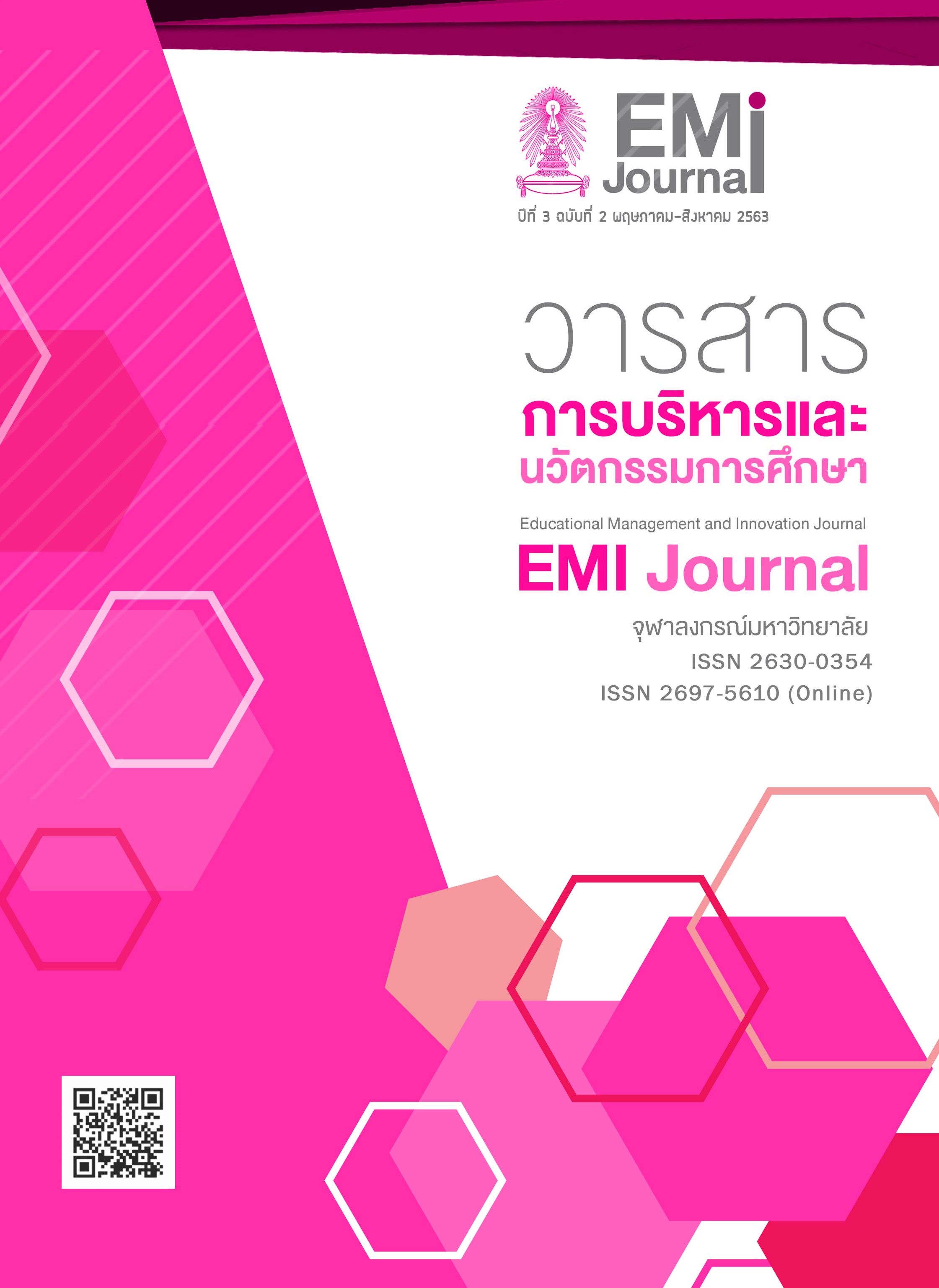ความต้องการจำเป็นในการพัฒนาการบริหารงานวิชาการโรงเรียนมัธยมศึกษา เพื่อการพัฒนาทักษะการคิดเชิงนวัตกรรมของนักเรียน
ความต้องการจำเป็นในการพัฒนาการบริหารงานวิชาการโรงเรียนมัธยมศึกษา เพื่อการพัฒนาทักษะการคิดเชิงนวัตกรรมของนักเรียน
คำสำคัญ:
การบริหารงานวิชาการ ทักษะการคิดเชิงนวัตกรรม ความต้องการจำเป็นในการพัฒนา โรงเรียนมัธยมศึกษาบทคัดย่อ
บทคัดย่อ
การวิจัยครั้งนี้ มีวัตถุประสงค์เพื่อศึกษาความต้องการจำเป็นในการพัฒนาการบริหารงานวิชาการโรงเรียนมัธยมศึกษามุ่งสู่การพัฒนาทักษะการคิดเชิงนวัตกรรม ใช้ระเบียบวิธีวิจัยเชิงปริมาณ กลุ่มตัวอย่างได้จากการสุ่มประชากรโดยกำหนดขนาดของกลุ่มตัวอย่างตามตารางของทาโร ยามาเน่ (Taro Yamane) ที่ระดับความเชื่อมั่น 95% และความคลาดเคลื่อน ±5% ได้ขนาดของกลุ่มตัวอย่างจำนวน 342 โรงเรียน และทำการสุ่มแบบแบ่งชั้น (Stratified Random Sampling) ตามภูมิภาค และสุ่มตัวอย่างอย่างง่าย(Simple Random Sampling) ผู้ให้ข้อมูล คือ ผู้อำนวยการ/รองผู้อำนวยการ หัวหน้าฝ่ายวิชาการ และครูโรงเรียนมัธยมศึกษา จำนวนทั้งสิ้น 1,026 คน เครื่องมือที่ใช้ในการวิจัย คือ แบบสอบถามมาตราส่วนประมาณค่า 5 ระดับ วิเคราะห์ข้อมูลโดยใช้สถิติค่าความถี่ ค่าร้อยละ ค่าเฉลี่ย ส่วนเบี่ยงเบนมาตรฐาน และค่าดัชนีความต้องการจำเป็น (PNImodified) ผลการวิจัย พบว่า ความต้องการจำเป็นในการพัฒนาการบริหารงานวิชาการโรงเรียนมัธยมศึกษามุ่งสู่การพัฒนาทักษะการคิดเชิงนวัตกรรม จำแนกตามการบริหารวิชาการในภาพรวม พบว่า ด้านการพัฒนาหลักสูตร มีลำดับความต้องการจำเป็นสูงสุด (PNImodified=0.286) รองลงมา คือ การจัดการเรียนการสอน (PNImodified=0.276) และด้านการวัดและประเมิน (PNImodified=0.270) ตามลำดับ เมื่อพิจารณาจำแนกตามทักษะการคิดเชิงนวัตกรรมของนักเรียน พบว่า การคิดขั้นสูง มีลำดับความต้องการจำเป็นสูงสุด (PNImodified=0.366) รองลงมาคือ ภาวะผู้นำเชิงสร้างสรรค์ (PNImodified=0.335) การคิดสร้างสรรค์ (PNImodified=0.330) การร่วมมือสืบเสาะ (PNImodified=0.317) และการคิดเชิงประยุกต์) (PNImodified=0.91) ตามลำดับ
Downloads
เอกสารอ้างอิง
Burkhardt, Gina et al. (2003). enGauge 21st Century Skills: Literacy in the Digital Age. Illinois: North Central Regional Educational Laboratory and the Metiri Group.
Chalamwong, Y. (2014). Thai workers in a new context: Vocational education for the nation. [Online]. Retrieved from http://tdri.or.th/tdri–insight/thai–labour–force/ [Febuary 17, 2017]
Chell, E., & Athayde, R. (2009). The Identification and Measurement of Innovative Characteristics of Young People: Development of the Youth Innovation Skills Measurement Tool. London: NESTA.
Cronbach, L. J. (1990). Essentials of psychological testing (5th ed.). New York: Harper & Row.
De Jong, J. P. J. (2007). Individual Innovation: The connection between Leadership and Employee Innovative Work Behavior. Zoetermeer: EIM.
Domrongpanit, S. (2018). The Relationships between the Results of External Educational Quality Assessment of the Office for National Educational Standards and Quality Assessment (2011-2015) and the Ordinary National-Educational Testing (O-Net) in the Basic Education Schools. [Online]. Retrieved from http://www.noesqa.or.th/th /th/contentlist-view/934/1560/ [January 13, 2020]
Drucker, F. Peter. (1999). Knowledge - Worker Productivity: The Biggest Challeng. California Management Review, 41(2), 78-94.
Horth, D., & Buchner, D. (2014). Innovation Leadership: How to use innovation to lead effectively work collaboratively and drive results. London: Center for Creative Leadership.
Kanchanawasri, S. (2009). Classical test theory (6th ed.). Bangkok: Chulalongkorn University. [in Thai]
Kleysen, F. Robert & Street, T. Christopher. (2001). Toward a multi-dimensional measure of individual innovative behavior. Journal of Intellectual Capital, 22(3), 284-296.
Luepong, P. (2012). The Competency Development of Human Resource. Executive Journal, 32(4), 103-108. [in Thai]
Maesincee, S. (2016). Thailand 4.0. [Online]. Retrieved from http://www.industry. go.th/ict/index.php?option=com_k2&view=item&id330. [March 11, 2016]
Ministry of Education. (2007). Ministerial Regulations define rules and procedures for decentralization of administration and education. (May 16, 2007). Royal Gazette. Vol.124 Part 24 a. [in Thai]
Panich, V. (2012). Ways to create the 21st Century Skills for students. Bangkok: Sodsri-Saridwongso Foundation. [in Thai]
Pholphirul, P. (2013). Creative Economy and Development Issues in Thailand. Nida Economic Review, 7(1), 1-4. [Online]. Retrieved from http://tcithaijo.org/index. php/NER//article/viewFile/22675/19396 [January 13, 2016]
Schwab, K. (2019). The Global Competitiveness Report 2019. Switzerland: World Economic Forum.
Sinlarat, P. (2006). Creative And Productive Education. Bangkok: Chulalongkorn University. [in Thai]
Solow, M. Robert. (1956). A Contribution to the Theory of Economic Growth. The Quarterly Journal of Economics, 70(2), 65-94.
Srisaard, B. (2011). Preliminary research (9th ed.). Bangkok: Suwiriyasat.
Sutthijakra, S. (2011). The Role of Universities in Producing Innovative Graduates. Bangkok: Dhurakij Pundit University. [in Thai]
Thailand Development Research Institute. (2014). Recommendations for Fundamental educational Reform. Bangkok: Thailand Development Research Institute. [in Thai]
Weiss, S. Davic & Legand, P. Claude. (2011). Innovative Intelligence. Ontario: John Wiley & Sons Canada, Ltd.
Wonganutaroj, P. (2010). Academic administration. Bangkok: Bangkok Supplementary
Media Center. [in Thai]
Wongwanich, S. (2015). Needs Assessment Research. Bangkok: Chulalongkorn University. [in Thai]
Wuttrirong, P. (2010). Innovation and Thailand's competitiveness Towards Creativity Economy. Chulalongkorn Review, 22(86), 43-67. [in Thai]
Yamane, T. (1973). Statistics: An Introductory Analysis (3rd ed.). New York: Harper and Row Publications.



